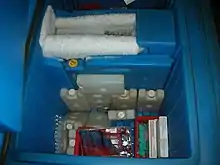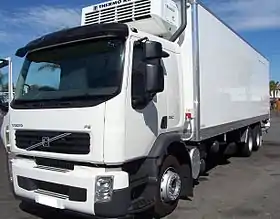Cold chain
A cold chain is a temperature-controlled supply chain. An unbroken cold chain is an uninterrupted series of refrigerated production, storage and distribution activities, along with associated equipment and logistics, which maintain quality via a desired low-temperature range.[1] It is used to preserve and to extend and ensure the shelf life of products, such as fresh agricultural produce,[2] seafood, frozen food, photographic film, chemicals, and pharmaceutical products.[3] Such products, during transport and when in transient storage, are sometimes called cool cargo.[4] Unlike other goods or merchandise, cold chain goods are perishable and always en route towards end use or destination, even when held temporarily in cold stores and hence commonly referred to as "cargo" during its entire logistics cycle.
| Food safety |
|---|
 |
| Terms |
| Critical factors |
| Bacterial pathogens |
| Viral pathogens |
| Parasitic pathogens |
History
Mobile refrigeration with ice from the ice trade began with reefer ships and refrigerator cars (iceboxes on wheels) in the mid-19th century. Mobile mechanical refrigeration was invented by Frederick McKinley Jones, who co-founded Thermo King with entrepreneur Joseph A. "Joe" Numero. In 1938 Numero sold his Cinema Supplies Inc. movie sound equipment business to RCA to form the new entity, U.S. Thermo Control Company (later the Thermo King Corporation), in partnership with Jones, his engineer. Jones designed a portable air-cooling unit for trucks carrying perishable food,[5] for which they obtained a patent on 12 July 1940,[6] subsequent to a challenge to invent a refrigerated truck over a 1937 golf game by associates of Numero's, Werner Transportation Co. president Harry Werner, and United States Air Conditioning Co. president Al Fineberg,[7][5][8][9]
This technology has been frequently in use since the 1950s, when it was most often used for preserving animal-based cells or tissue. As medical breakthroughs, such as in cancer treatment, have taken place, the demand for cold chain systems has grown. The COVID-19 pandemic and its associated vaccinations, have caused vastly increased need.[10]
Uses

Cold chains are common in the food and pharmaceutical industries and also in some chemical shipments. One common temperature range for a cold chain in pharmaceutical industries is 2 to 8 °C (36 to 46 °F), but the specific temperature (and time at temperature) tolerances depend on the actual product being shipped.
Produce
Unique to fresh produce cargoes, the cold chain requires to additionally maintain product specific environment parameters[2] which include air quality levels (carbon dioxide, oxygen, humidity and others).
Vaccines
The cold chain is used in the supply of vaccines to distant clinics in hot climates served by poorly developed transport networks. Disruption of a cold chain due to war may produce consequences similar to the smallpox outbreaks in the Philippines during the Spanish–American War, during which the distributed vaccines were inert due to lack of temperature control in transport.[11]
For vaccinations in particular, there are different types of cold chains. There is an ultralow, or deep freeze, cold chain for vaccines that require -70 degrees C. The Ebola and Pfizer–BioNTech COVID-19 vaccines require this level, as do some animal vaccinations, such as those for chickens. Next the frozen chain requires -20 degrees C. Varicella and zoster vaccinations require this level. Then the refrigerated chain, which requires temperatures between two and eight degrees C. Most flu vaccinations only require refrigeration.[12]
In 2020 during the COVID-19 pandemic, vaccines being developed may need ultracold storage and transportation temperatures as cold as −70 °C (−94 °F), requiring what has been referred to as a "colder chain" infrastructure.[13] This creates some issues of distribution for the Pfizer vaccine. It is estimated that only 25 to 30 countries in the world have the infastructure for the required ultracold cold chain.[12]
Validation


The cold chain distribution process is an extension of the good manufacturing practice (GMP) environment that all drugs and biological products are required to follow, and are enforced by the various health regulatory bodies. As such, the distribution process must be validated to ensure that there is no negative impact to the safety, efficacy or quality of the drug substance. The GMP environment requires that all processes that might impact the safety, efficacy or quality of the drug substance must be validated, including storage and distribution of the drug substance.[13][1]
A cold chain can be managed by a quality management system. Temperature data loggers and RFID tags help monitor the temperature history of the truck, warehouse, etc. and the temperature history of the product being shipped.[14] They also can help determine the remaining shelf life.[15] Also, temperature sensors may need to be National Institute of Standards and Technology (NIST) traceable depending on the body monitoring the cold chain.[16]
See also
- Bacterial growth
- Cool Chain Quality Indicator (CCQI)
- Dry Ice
- Frank Vale, an Australian cold storage industry and dairy factory industry pioneer
- HACCP
- Insulated shipping container
- Packaging
- Shelf life
- Temperature control
- Temperature data logger
- Time temperature indicator
- Thermal decomposition
- Thermal insulation
- Tolerance (engineering)
- Transportation management system
- United States Pharmacopeia
- Validation (drug manufacture)
- Verification and validation
- ULT freezer
References
- "The Vaccine Cold Chain" (PDF). www.who.int. WHO. Retrieved 19 December 2020.
- Kohli, Pawanexh. "Fruits and Vegetables Post-Harvest Care: The Basics" (PDF). CrossTree techno-visors.
- Gyesley, S. W. (1991). "Total Systems Approach to Predict Shelf Life of Packaged Foods". ASTM STP 1113-EB. Cite journal requires
|journal=(help) - Lou Smyrlis (19 September 2013). "CN's Claude Mongeau preaches 'eco-system of collaboration' at Port Days" Archived 21 September 2013 at the Wayback Machine, Canadian Transportation Logistics, Retrieved 20 September 2013
- "Frederick McKinley Jones". Minnesota Science and Technology Hall of Fame. Minnesota High Tech Association / Science Museum of Minnesota. Retrieved 11 February 2010.
- Smith, Jessie Carney (2012). Black Firsts: 4,000 Ground-Breaking and Pioneering Historical Events. Visible Ink Press. p. 613. ISBN 978-1-57859-424-5.
- Eight Black American Inventors by Robert C. Hayden Addison-Wesley, 1972; pp. 46- 50.
- Smith, Jessie Carney (2012). Black Firsts: 4,000 Ground-Breaking and Pioneering Historical Events. Visible Ink Press. p. 613. ISBN 978-1-57859-424-5.
- "Air Conditioning and Refrigeration History - part 4 - Greatest Engineering Achievements of the Twentieth Century". www.greatachievements.org. Archived from the original on 3 December 2016. Retrieved 24 April 2018.
- Kelly, Kate (15 December 2020). "Critical to Vaccines, Cold Storage Is Wall Street's Shiny New Thing". nytimes.com. The New York Times. Retrieved 20 December 2020.
- "Office of Medical History". history.amedd.army.mil. Archived from the original on 16 February 2017. Retrieved 24 April 2018.
- Fischetti, Mark (19 November 2020). "The COVID Cold Chain: How a Vaccine Will Get to You". www.scientificamerican.com. Scientific American. Archived from the original on 19 November 2020. Retrieved 20 December 2020.
- Derek Lowe (31 August 2020). "Cold Chain (And Colder Chain) Distribution". Science Translational Medicine. Retrieved 5 September 2020.
- Riva, Marco; Piergiovanni, Schiraldi, Luciano; Schiraldi, Alberto (January 2001). "Performances of time-temperature indicators in the study of temperature exposure of packaged fresh foods". Packaging Technology and Science. 14 (1): 1–39. doi:10.1002/pts.521.
- Meyers, T (June 2007). "RFID Shelf-life Monitoring Helps Resolve Disputes". RFID Journal. Archived from the original on 30 June 2009.
- "Cold Chain Temperature Monitoring – Absolute Automation Blog". absoluteautomation.com. 27 May 2016. Archived from the original on 24 April 2018. Retrieved 24 April 2018.
Further reading
- Protecting Perishable Foods During Transport by Truck, USDA Handbook 669, 1995
- Brian Lassen, "Is livestock production prepared for an electrically paralysed world?" J. Sci. Food Agric. 2013;93(1):2–4, Explains the vulnerability of the cold chain from electricity dependence.
- Manual on the Management, Maintenance and Use of Blood Cold Chain Equipment, World Health Organization, 2005, ISBN 92-4-154673-5
- Pawanexh Kohli, "Fruits and Vegetables Post-Harvest Care: The Basics", Explains why the cold chain is required for fruits and vegetables.
- Clive, D., Cold and Chilled Storage Technology, 1997, ISBN 0-7514-0391-1
- EN 12830:1999 Temperature recorders for the transport, storage and distribution of chilled, frozen and deep-frozen/quick-frozen food and ice cream
- Ray Cowland, Developing ISTA Cold Chain Environmental Standards, 2007.
